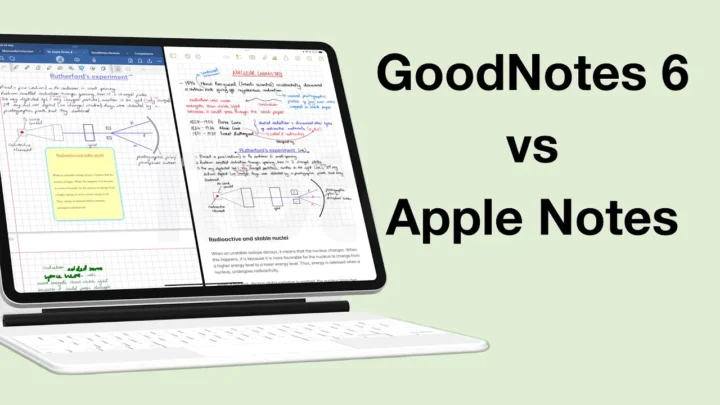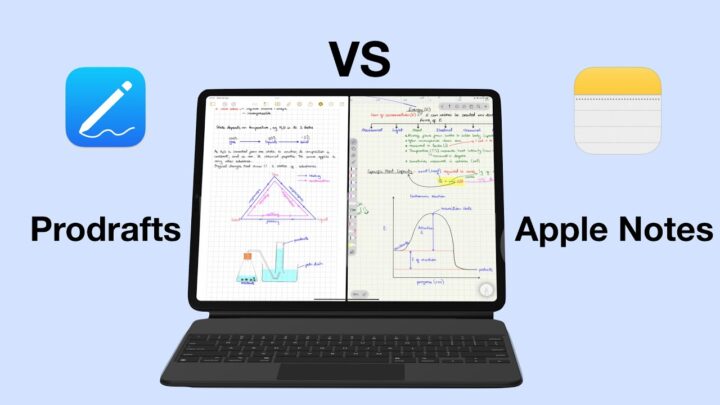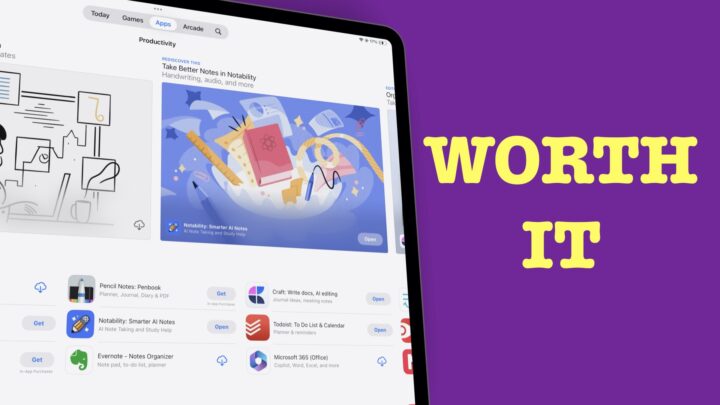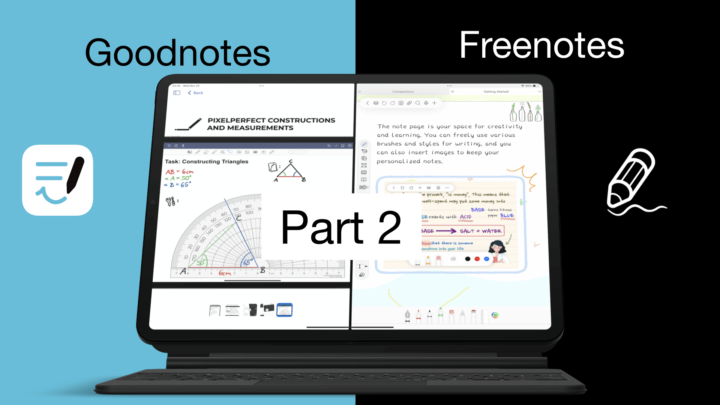We’ve reviewed many handwriting note-taking apps but still get many questions about individual features. In this article, we’ll compare fountain pens across different iPad and Android handwriting apps we have reviewed so far, ranking them from the worst to the best. We’re talking tip sharpness, pressure sensitivity-the whole nine yards!
Like the physical fountain pen, a fountain pen in a handwriting note-taking app is meant to make writing easier. So, you’ll use less effort when writing. It should give you a stroke with varying width and tip sharpness. We’ll focus on those features to evaluate how good fountain pens are in different handwriting note-taking apps.
Apps with no fountain pen
Before we start our countdown, which will surprise you, let’s quickly go through apps without a fountain pen. Apple Notes and OneNote on the iPad, don’t have fountain pens. The apps even mention the tool. You also have apps that have fountain pens, but according to our criteria, they are not really fountain pens. Noteshelf 3 and Nebo both have a calligraphy pen, which they have labelled as a fountain pen. In both apps, the pen stroke does not vary when you’re writing, and the tools lack any customisation. Samsung Notes doesn’t have a fountain pen, but it doesn’t look like a calligraphy pen like the other two apps. It’s more like a really good ballpoint pen.
Notability
Notability’s fountain pen does not vary in thickness when you write on the iPad, which should disqualify it as a fountain pen according to our criteria. It has no options to personalize the pen tool, and your letter ends are not tapered. But writing with the tool is very easy and pleasant. Pressure sensitivity is the only feature that qualifies the fountain pen in Notability. You can’t adjust it, but pressing harder when writing changes the pen thickness significantly. That is probably the biggest difference between a ballpoint pen and a fountain in digital note-taking.
Squid
Squid on Android has a similar setup to that of Notability on the iPad. The only difference is that you can turn on the pressure sensitivity to switch to the fountain pen. The app is very responsive to how hard you press on the screen, but compared to Notability, the handwriting feels and looks much better in Squid. That is why it ranks a little higher.
ZoomNotes
ZoomNotes on the iPad has many pen tools, one of the most you will find in a handwriting note-taking app. The fountain pen in the app is called a nib pen, which you can customise from looking like a ballpoint pen to a decent fountain pen. The app does not have a pressure sensitivity option, so whether you press hard or not, your stroke thickness doesn’t change. You have several options to play around with for your thickness range, but ultimately, you can get some really thin strokes. If you like controlling your tips, you might not like the fountain pen in ZoomNotes because it doesn’t have that option. The tool gets points for its opacity option, though.
Notes Plus X
Notes Plus X on the iPad had a very impressive fountain pen a couple of years back when the apps were few. Even today, the tool setting for varying stroke thickness is still impressive for a fountain pen. At its thinnest, your pen stroke becomes almost invisible. Your handwriting looks great without much effort. However, you don’t get tip options, so the app determines the type of tips you get for your fountain pen; they tend to be rounded at the beginning of your letters and tapered at the end, but you don’t have much control over that. Notes Plus X also doesn’t give you pressure sensitivity and opacity options. Its visibly raster ink makes it rank lower.
The pen tool in the app has an additional feature, which other handwriting note-taking apps on the list haven’t managed to replicate: fill for your pens—not just the fountain pen but all of them. It can be any colour you like, and you can adjust its opacity. What do you think about how it looks?
Collanote
The pen tool labelled fountain pen in Collanote doesn’t have any thickness variation in your strokes, so we looked for a better fountain pen. To our surprise, we found it from the modern calligraphy pen which gives you a look similar to the tool in Notability. It has a negligible thickness variation that you mostly see at the beginning of your letters. You have to try hard to find it. It also does not respond to pressure, so your stroke thickness is unaffected whether you’re pressing hard or lightly on your screen.
The opacity option and stabiliser allow you to customise your pens in Collanote. At its most basic, your pen stroke is not smooth, but writing in the app is easy. You don’t put too much effort. Increasing the stabiliser gives you smoother strokes but more resistance in your writing. You’ll have to put more effort into writing, and that really gives everyone an opportunity to personalise their fountain pen.
Goodnotes 6
Goodnotes 6 was the first handwriting note-taking app to give tip options for the fountain pen. Your pen can either have a rounded or sharp tip, which in the app mostly affects the end of your letters, not their end. But it’s inconsistent. Pressure sensitivity is brilliant in Goodnotes. You can get super thin and thick strokes without changing your pen thickness. With less pressure on the screen, you get thin strokes, but when you apply more pressure, you can get a stroke twice as thick.
The fountain pen in Goodnotes doesn’t have any thickness range, though. Your pen stroke thickness is evenly distributed, which is disappointing for a fountain. But, it has an option for the flatness of your tip, which makes the pen look more calligraphy.
Jnotes
Without a specific setting for it, Jnotes on Android has some decent tapered ends that are mostly at the end of your letters rather than at the beginning. You do get the occasional tapered beginning, but it’s rare. Your handwriting looks much better than it does in Goodnotes 6 on the iPad, writing is more pleasant too. Jnotes has a wider range of pressure sensitivity and is very responsive. We get some thickness range in Jnotes, nothing exciting, though. The opacity for your colours is effectively the opacity for your pen tool, so the app scores some marks for that.
Freenotes
Freenotes on the iPad manages to taper both ends of your letters, and it simply looks amazing, especially when you’re using a thin pen. However, because the tool’s thickness range is terrible, the tapered ends can look awkward or too abrupt for thicker pens. Pressure sensitivity is decent and quite sensitive. A light press creates thin strokes, and a hard press a really thick one. Lastly, you get an opacity option for your fountain pen.
Notein
Notein on Android has the most impressive pressure sensitivity range we have seen in a handwriting note-taking app. The fountain pen stroke becomes significantly thinner the more pressure sensitivity you use. It also makes the
tips sharper. But it lacks the thickness range you’d want for a fountain pen because the whole letter becomes thin and doesn’t really vary. The tool also has an opacity option for your colours, which directly affects the tool itself. Its ink-flow option we’re still trying to figure out. It doesn’t have any obvious effects that jump out of the screen to appreciate them. But still, it’s definitely one of the best fountain pens you can use for digital note-taking.
Noteful
If you don’t like the abrupt tapering on the fountain pen in Freenotes, you’ll appreciate Noteful because the app lets you adjust that. Both ends of your pen tool are tapered, making your handwriting look good. It also has the stabiliser you get from CollaNote, where you can increase the resistance in your writing while making the pen stroke smoother. The fountain pen in Noteful also has very high-pressure sensitivity, where a light press really does make a difference. The thickness range in your pen stroke is not the most amazing, though. It’s there, but it’s nothing to be excited about. The only feature missing in Noteful for your fountain pen is opacity. Noteful definitely has the best fountain pen in a handwriting note-taking app.
Final thoughts
Do you agree with our list? Which of these do you think looks the best? Do you know an app that should be on this list? Let us know so we can try it out. What other feature would you like us to dissect?





